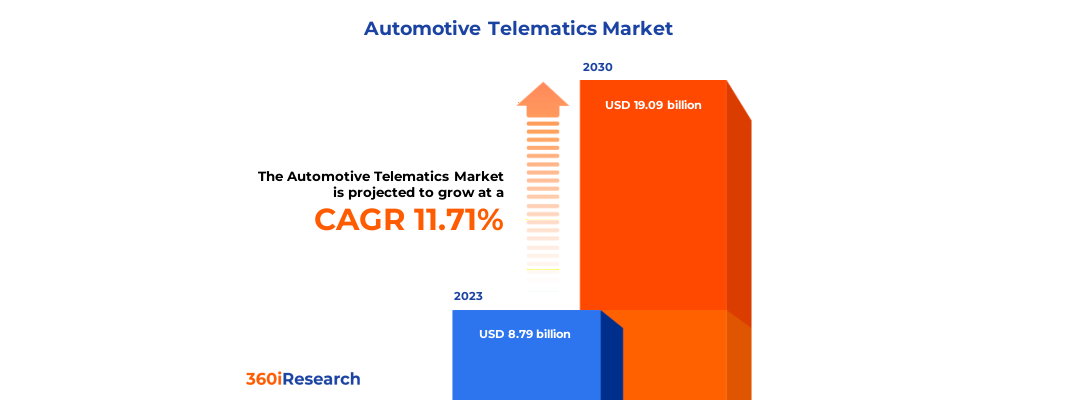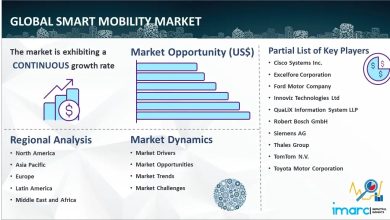Global automotive telematics market to reach $19.09B by 2030

The “Automotive Telematics Market by Technology (Embedded, Integrated, Tethered), Offering (Hardware, Services, Software), Vehicle, Application, End-User – Global Forecast 2024-2030” report has been added to 360iResearch. The Global Automotive Telematics Market to grow from USD 8.79 billion in 2023 to USD 19.09 billion by 2030, at a CAGR of 11.71%.
Automotive telematics refers to the integrated use of telecommunications and informatics for applications in vehicles and to control vehicles on the move. This technology enables the transmission of digital information, including vehicle location, speed, and diagnostics, to and from vehicles through wireless networks. The major factors contributing to the expansion of automotive telematics use include the growing demand for safer driving experiences, enhanced operational efficiency in fleet management, regulatory mandates for vehicle safety, and the rising adoption of connected vehicle technology.
However, concerns over data privacy and security, the high cost of implementation, and potential distractions to drivers impact their utility among end-users. Addressing these issues requires robust cybersecurity measures, clear regulatory guidelines, and the integration of user-friendly interfaces to minimize distractions. The future of automotive telematics holds promising opportunities with the advent of autonomous vehicles, the expansion of electric vehicle infrastructure, and the potential for telematics to contribute to smarter, more efficient cities by managing traffic flow and reducing emissions.
In the Americas, there is a high adoption rate of advanced telematics solutions driven by stringent regulatory requirements for safety and emission controls and a strong consumer demand for connectivity and vehicle automation. Major companies in this region leverage their robust technological infrastructure and strategic partnerships to innovate and capture market share. In the APAC region, the market is witnessing rapid expansion, attributed to the burgeoning automotive industry in countries such as China and India.
The integration of telematics is increasingly becoming a standard feature in mid-range vehicles. This is owing to the cost-effective production capabilities and the growing appetite for connected vehicle technology among the expanding middle class. Companies in the region are offering localized solutions and fostering collaboration across automotive manufacturers to meet region-specific regulatory standards and consumer preferences. Western European countries display a high penetration of telematics. Elevated consumer expectations for safety and connectivity, alongside rigorous EU regulations on vehicle telematics, drive this.
Market Segmentation & Coverage:
This research report categorizes the Automotive Telematics Market in order to forecast the revenues and analyze trends in each of following sub-markets:
Based on Technology, market is studied across Embedded, Integrated, and Tethered. During the forecast period, analysts project that The Tethered will capture a significant market share.
Based on Offering, market is studied across Hardware, Services, and Software. The Hardware is further studied across Audio/Video Interface, Communication Devices, Navigation Systems, and Telematic Control Unit. The Services is further studied across Consulting and Installation & Maintenance. The Software is projected to witness significant market share during forecast period.
Based on Vehicle, market is studied across Commercial Vehicles and Passenger Cars. The Commercial Vehicles is further studied across Agricultural Vehicles, Buses & Coaches, Forklift, Port Vehicle & Internal Container Handling Vehicle, Heavy & Special Duty Truck, Light Electric Vehicle, and Medium & Heavy Duty Vehicle. The Passenger Cars is projected to witness significant market share during forecast period.
Based on Application, market is studied across Diagnostics, Fleet Management, Infotainment & Navigation, and Safety & Security. During the forecast period, analysts project that the Diagnostics sector will capture a significant market share.
Based on End-User, market is studied across Aftermarket and OEMs. During the forecast period, analysts project that the OEMs will significantly increase their market share.
Based on Region, market is studied across Americas, Asia-Pacific, and Europe, Middle East & Africa. The Americas is further studied across Argentina, Brazil, Canada, Mexico, and United States. The United States is further studied across California, Florida, Illinois, New York, Ohio, Pennsylvania, and Texas. The Asia-Pacific is further studied across Australia, China, India, Indonesia, Japan, Malaysia, Philippines, Singapore, South Korea, Taiwan, Thailand, and Vietnam. The Europe, Middle East & Africa is further studied across Denmark, Egypt, Finland, France, Germany, Israel, Italy, Netherlands, Nigeria, Norway, Poland, Qatar, Russia, Saudi Arabia, South Africa, Spain, Sweden, Switzerland, Turkey, United Arab Emirates, and United Kingdom. The Europe, Middle East & Africa commanded largest market share of 37.28% in 2023, followed by Americas.
FPNV Positioning Matrix:
The FPNV Positioning Matrix is essential for assessing the Automotive Telematics Market. It provides a comprehensive evaluation of vendors by examining key metrics within Business Strategy and Product Satisfaction. This allows users to make informed decisions based on their specific needs. This advanced analysis then organizes these vendors into four distinct quadrants, which represent varying levels of success: Forefront (F), Pathfinder (P), Niche (N), or Vital(V).
Market Share Analysis:
The Market Share Analysis offers an insightful look at the current state of vendors in the Automotive Telematics Market. By comparing vendor contributions to overall revenue, customer base, and other key metrics, we can give companies a greater understanding of their performance and what they are up against when competing for market share. The analysis also sheds light on just how competitive any given sector is about accumulation, fragmentation dominance, and amalgamation traits over the base year period studied.


